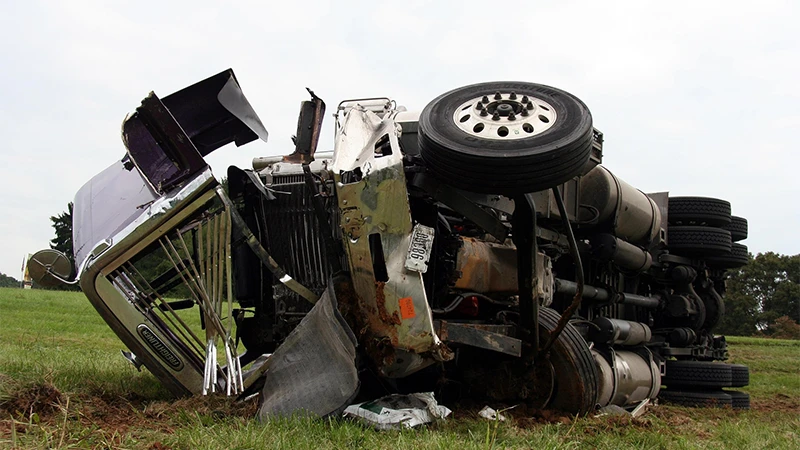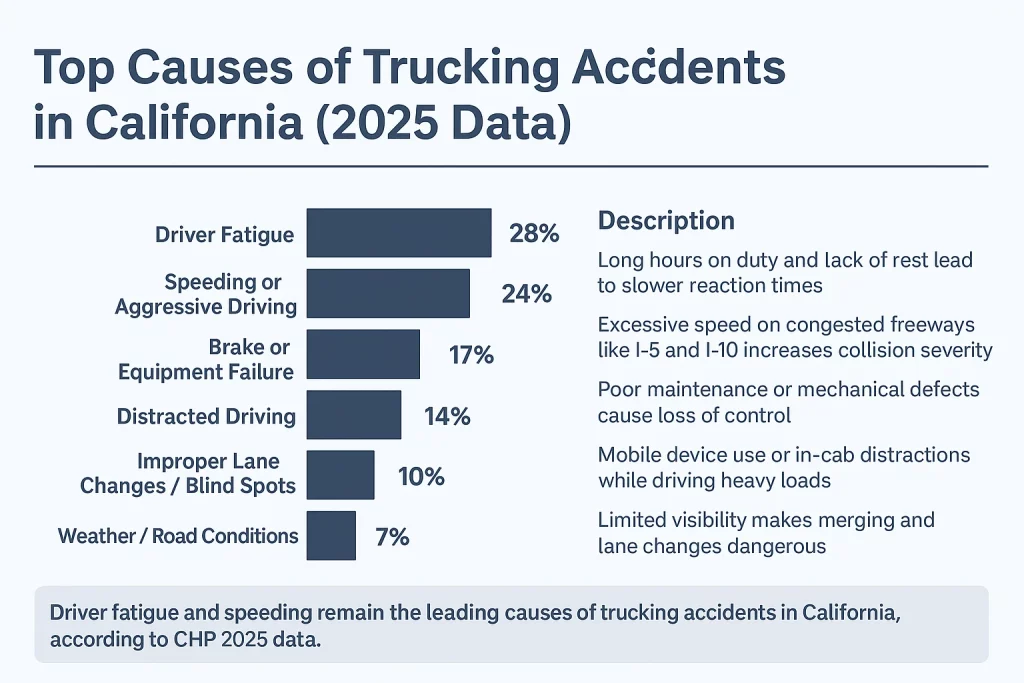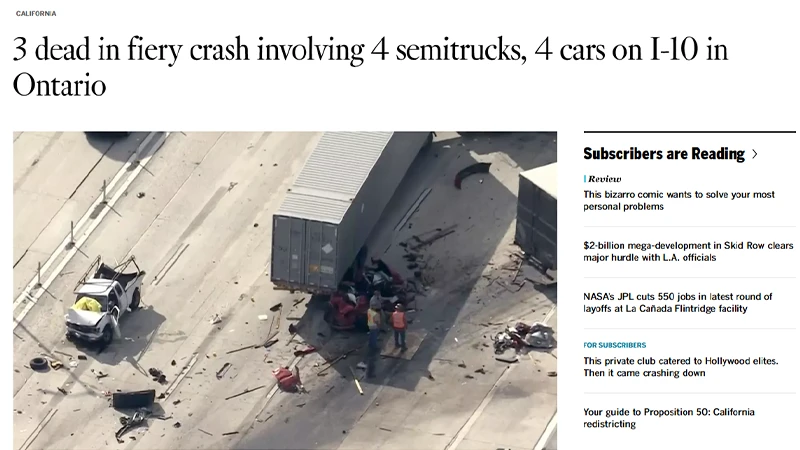
1️⃣ Understanding Trucking Accidents in California
Trucking accidents in California are among the most devastating roadway events due to the state’s heavy freight traffic.
Major corridors such as I-10, I-5, and I-15 connect ports in Los Angeles and Long Beach to logistics hubs across the Southwest.
According to the California Highway Patrol (CHP), over 12,000 trucking accidents occur each year.
The National Highway Traffic Safety Administration (NHTSA) also reports that large trucks are involved in 9% of fatal crashes, despite representing less than 5% of total vehicles.

2️⃣ Case Study: The I-10 Ontario Crash

On October 21, 2025, a fiery multi-vehicle collision involving semi-trucks and passenger cars on Interstate 10 near Ontario, CA, claimed three lives and shut down traffic for hours.
Witnesses told the Los Angeles Times that one of the semis failed to brake in time, triggering a chain reaction that engulfed multiple vehicles in flames.
This tragic case highlights why Trucking Accidents in California demand careful investigation into both driver and company liability.
3️⃣ Who Is Legally Responsible in a Trucking Accident?
California law evaluates liability under negligence principles and federal trucking regulations.
⚖️ The Truck Driver
A truck driver may be found negligent if they:
- Fail to maintain safe speed or distance,
- Drive fatigued or distracted,
- Ignore braking signals or road hazards.
If the driver’s inaction directly causes death or injury, they may face civil liability—and even vehicular manslaughter charges under California Penal Code §192(c) in extreme cases.
🧾 The Trucking Company
Under the doctrine of respondeat superior (Civil Code §2338), employers are responsible for their driver’s negligence if the driver was “within the scope of employment.”
Additionally, a carrier may face independent liability for:
- Failing to maintain the vehicle properly,
- Poor driver training or screening,
- Ignoring federal Hours of Service (HOS) rules.
4️⃣ Comparative Negligence: Shared Fault in California
California uses a pure comparative negligence rule (Civil Code §1431.2).
Even if a passenger car driver contributed partially—say, by speeding or changing lanes too quickly—they can still recover damages, reduced by their fault percentage.
Example: If total damages equal $1 million and the car driver is 10% at fault, they can still recover $900,000.
Top Causes of Trucking Accidents in California (2025 Data)
The California Highway Patrol (CHP) and NHTSA identify several key factors contributing to trucking crashes each year.
The chart below illustrates the leading causes of Trucking Accidents in California:
| Cause of Accident | Percentage of Crashes | Description |
|---|---|---|
| Driver Fatigue | 28% | Long hours on duty and lack of rest lead to slower reaction times. |
| Speeding or Aggressive Driving | 24% | Excessive speed on congested freeways like I-5 and I-10 increases collision severity. |
| Brake or Equipment Failure | 17% | Poor maintenance or mechanical defects cause loss of control. |
| Distracted Driving | 14% | Mobile device use or in-cab distractions while driving heavy loads. |
| Improper Lane Changes / Blind Spots | 10% | Limited visibility makes merging and lane changes dangerous. |
| Weather / Road Conditions | 7% | Rain, fog, and low visibility affect braking distance and handling. |
5️⃣ How Other Drivers Can Prevent Trucking Accidents
Safety around large trucks depends on awareness and distance:
- Stay out of blind spots: Don’t linger beside or behind a truck.
- Maintain space: Keep at least a four-second following distance.
- Signal early: Trucks need over 400 feet to stop when traveling 55 mph.
- Avoid cutting off trucks: Abrupt braking can cause fatal rear-end crashes.
- Report unsafe truck driving: Call 1-800-TELL-CHP if you see erratic behavior.
These habits dramatically reduce the risk of Trucking Accidents in California highways.

6️⃣ Insurance Strategies for California Drivers
🧾 For Trucking Companies
Federal law requires commercial carriers to carry at least:
- $750,000 for general freight
- $1 million for oil transport
- $5 million for hazardous materials
However, due to California’s high verdicts, most trucking firms now maintain $2–5 million in liability coverage, plus cargo, trailer, and umbrella policies.
🚗 For Everyday Drivers
California’s minimum insurance requirements are:
- $15,000 bodily injury (per person)
- $30,000 bodily injury (per accident)
- $5,000 property damage
These minimums are rarely enough in a trucking crash.
Drivers are encouraged to carry:
- 100/300/100 liability limits
- Uninsured/Underinsured Motorist (UIM) coverage
- Medical Payments (MedPay) for immediate hospital costs
- Gap insurance for financed vehicles
Free Car Injury Settlement Calculator
Estimated Settlement Range
Please enter your data to see estimate
This guide explains how the Accident Settlement Calculator works and what factors influence your potential compensation. Click here to learn more in our detailed calculator guide
7️⃣ Conclusion: Staying Safe and Prepared
The I-10 Ontario crash serves as a sobering example of what can happen when a semi-truck fails to brake on time.
Under California law, both the truck driver and their employer likely share primary responsibility.
For other motorists, the best defense is proactive driving and adequate insurance coverage that reflects the real risks of traveling alongside massive commercial vehicles.
Trucking accidents in California are complex—but with legal awareness, defensive driving, and smart insurance planning, drivers can stay protected both on the road and in the courtroom.






